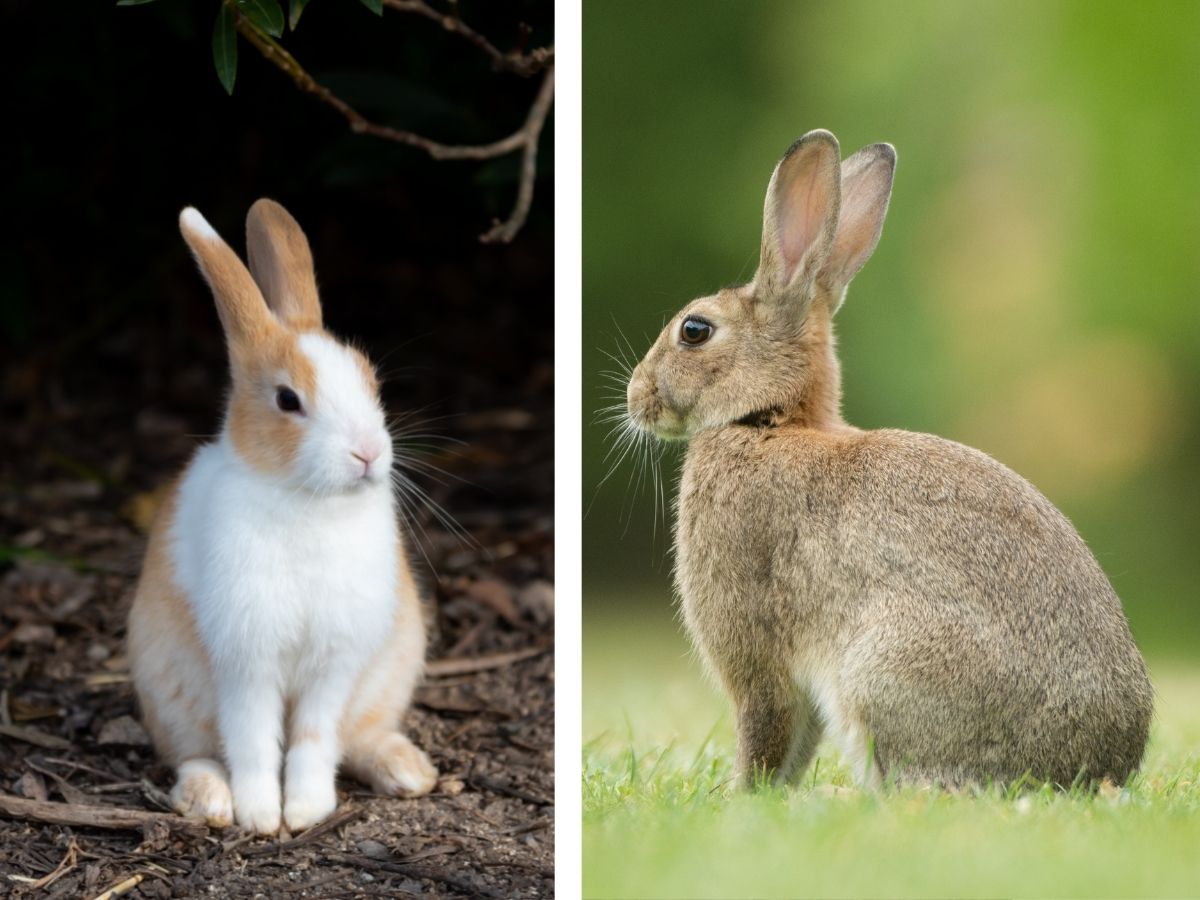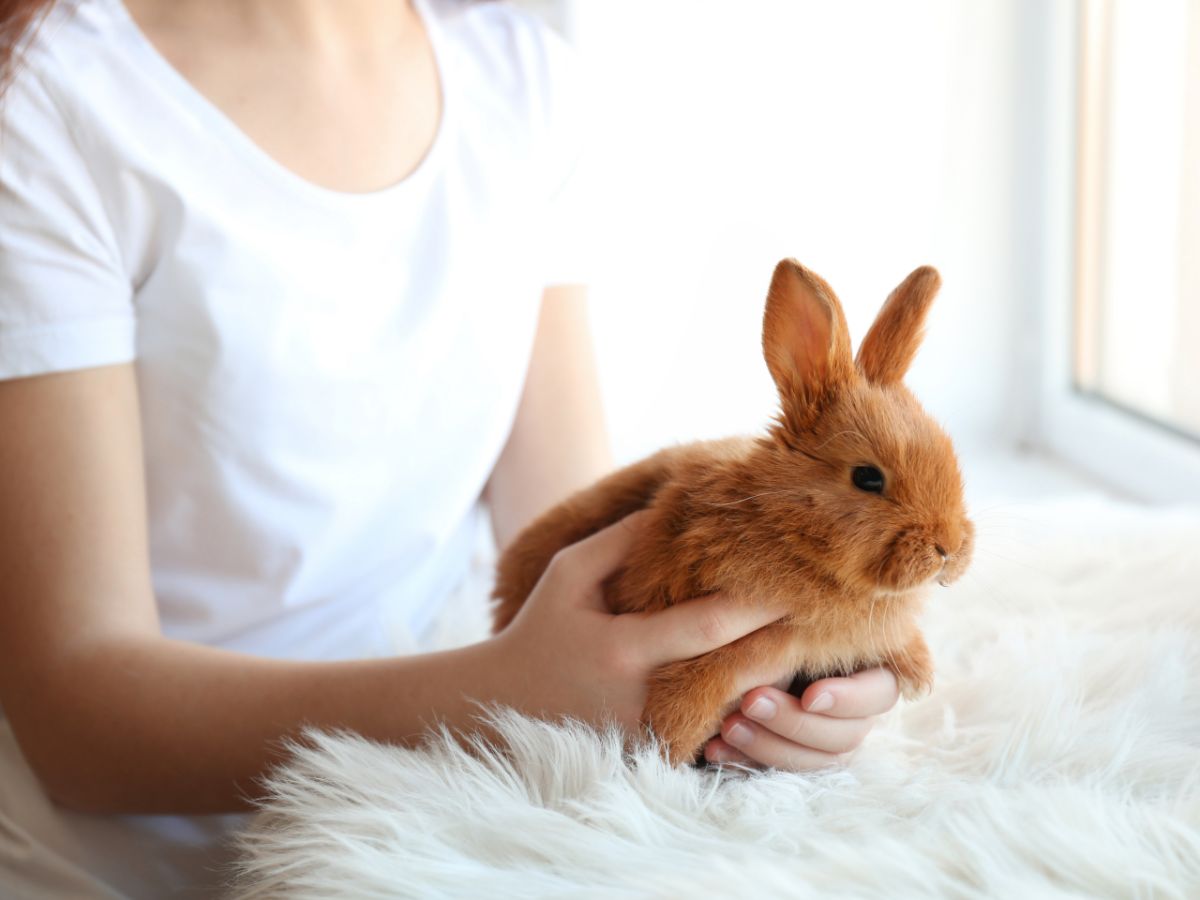If you love spending your extra time in nature, you have probably seen loads of rabbits. Wild rabbits are very common in fields and parks, or you might even catch them nibbling on the veggies in your garden! These rabbits may belong to the same species, and you may think they share a lot of traits, but this is not always the case.
Wild and domestic rabbits differ in size, ears, and face shape. Their colors are also different, and they have different diets. Wild rabbits live shorter than domestic ones and are usually found alone. Wild rabbits never allow humans close to them, whereas a domestic one will bond with humans.
When we notice a rabbit all on its own, our instincts may tell us they need to be rescued. However, by knowing the differences between a wild and domestic rabbit, you will know how to determine if a bunny needs your help and if it is simply just a wild rabbit enjoying its life!
Contents
Origin of the domestic rabbit
For a very long time, wild and domestic rabbits were the same. It took over 2,000 years of breeding rabbits in captivity before any huge differences were noticed. Although wild and domestic rabbits will share some of the same similarities, these two are very different today.
America is the home to 14 species of wild rabbits, including cotton tails, which are part of the Sylvilagus or Lepus genus. On the other hand, domestic rabbits belong to the Oryctolagus genus and stem from Europa. However, the differences don’t stop here.
Let’s look at all the differences between a wild and a domestic rabbit:
All the differences at a glance: Wild rabbits vs. domestic rabbits
| Wild rabbit | Domestic rabbit | |
| Species | Cottontail rabbits (Genus: Sylvilagus) | domestic European rabbit (Oryctolagus cuniculus domesticus) |
| Size | 8 to 20 inches (20 to 50 cm) | Netherland Dwarf rabbits: 7 to 15 inches (20 bis 40 cm) Flemish Giant rabbit: 28 inches (72 cm) |
| Weight | 5 pounds (2,2 kg) | Netherland Dwarf rabbits: 2,4 to 3,3 lbs (1,1 to 1,5 kg) Flemish Giant rabbit: 17 lbs (8 kg) |
| Coat color | light brown with a white tail | Variety of coat colors and patterns: brown, red, white, black, spotted |
| Ears | 2 to 3,5 inches (6 to 9 cm) | Flemish Giant rabbit: at least 6 inches (17 cm) Netherland Dwarf rabbits: 1,9 to 2,3 inches (5 to 6 cm) |
1. Size Differences: Wild Vs. Domestic Rabbits
Wild rabbits will measure anywhere from eight to twenty inches in length, weighing one to five pounds. Wild rabbits usually only grow to a specific size, including Cottontails. This is usually the size of a wild rabbit that can be seen in backyards, parks, and other natural areas.
Domesticated rabbits can vary greatly in size. The largest and heaviest rabbit breed, the Flemish Giant rabbit weighs up to 17 lbs (8 kg) and can grow up to 28 inches (72 cm) tall. Netherland Dwarf rabbits, on the other hand, weigh only 2,4 to 3,3 lbs (1.1 to 1.5 kg) and are ranging in size from 7 to 15 inches (20 to 40 cm).
2. Ear Appearance: Wild Vs. Domestic Rabbits
One of the main differences between a wild and a domestic rabbit lies in its ears. However, the ears might not be enough to determine whether a rabbit is wild or not, as all rabbit’s ears will be upright if they are alert or stressed.
Usually, a wild rabbit will have ears that stay upright, with domesticated rabbit’s ears being more floppy. However, wild rabbits native to the U.S. will have floppy ears, even if it is wild or domesticated. The longest ears have Flemish Giant rabbit with at least 6 inches (17 cm), Netherland Dwarf rabbit, on the other hand, have even smaller ears than wild rabbits, with 1,9 to 2,3 inches (5 to 6 cm).
3. Face Structure: Wild Vs. Domestic Rabbits
When you can observe the facial structure of a wild or domestic rabbit, it could help you significantly in determining one or the other. A wild rabbit will have a longer and more narrow face than a domestic one.
Its eyes will almost be almond-shaped. Many of these features are because of a wild rabbit’s diet, but we’ll get into that in just a bit!
A domestic rabbit will have a much shorter, thicker, chubby face. Although facial shapes are subtle features in a rabbit, they could also be the features that factor into an accurate determination between the two!

4. Overall Color And Coat: Wild Vs. Domesticated Rabbits
Looking at a rabbit’s color and coat is almost a fool-proof way to determine whether it’s wild or domesticated. This could become incredibly helpful if you happen to stumble upon a litter of babies without its mother supervising them.
In most cases, a wild rabbit’s fur will be light brown, with a white tail. A wild rabbit’s coat will also be coarser than a domestic one.
The fur of a domestic rabbit will largely depend on its breed, as some of them could be solid gray, red, brown, black, or tri-colored, amongst many other colors.
5. Diet: Wild Vs. Domestic Rabbits
All rabbits might be herbivores, but there are significant differences in the diest of a wild and domestic rabbit. While wild rabbits will forage for their food, eating anything from flower buds, shrubs, grass, cover, and anything else green they can get their paws on, this is not the case with domestic ones.
A domestic rabbit’s diet depends entirely on what its owner provides it with. Most owners will feed their pet rabbits a combination of lettuce, cucumbers, carrots, and hay.
Domestic rabbits are also fed pellets in small amounts, which could be difficult to digest.
6. Lifespan: Wild Vs. Domestic Rabbits
There’s a significant difference in the lifespan of wild and domestic rabbits. Wild rabbits will live only one to two years, as they are a source of food for many predators, and they need to fend for themselves. Domestic rabbits have a much longer lifespan, ranging from six to ten years.
7. Social Activity And Companionship: Wild Vs. Domestic Rabbits
Wild rabbits are known as solitary animals, although they may be found living close to each other. It’s also not uncommon for a single wild rabbit to live alone in a garden or backyard. However, wild rabbits will be seen together more often during the breeding season.
Domestic rabbits are much more social than wild rabbits. They can become anxious and depressed when their owners do not keep them in pairs, and some domestic rabbits are kept together since birth. An escaped pet rabbit is more likely to wander alone, and they will struggle to adapt to an established group of wild rabbits.

8. Personality And Approachability: Wild Vs. Domestic Rabbits
Wild rabbits will never approach a human, and if you try to catch them, they will scream, kick, run, and you might even receive a painful bite.
Wild rabbits are always cautious towards people and will always keep their distance. These wild animals have to be on guard constantly for threats and predators.
Domestic rabbits make such popular pets due to their affectionate and sweet personalities. Domestic rabbits are more trusting of humans, as it is all they know. So if a rabbit approaches you, it has run away from its home and got lost.
Can wild rabbits and domestic rabbits mate?
The answer depends on where you live. If you are living in England or Europe then the answer is YES. If you live in the U.S. then the answer is NO.
Pet rabbits are the domesticated form of the European rabbits. Through this close relationship the different rabbits can actually breed and give birth to healthy offsprings.
The wild rabbits in the U.S. are a different species: Cottontail rabbits. Domesticated rabbits and Cottontail rabbits cant breed, because they have different numbers of chromosomes. Cottontail rabbits have 21 and Domesticated/ European rabbits have 22 chromosomes.
Can a domestic rabbit survive in the wild?
Domesticated rabbits, due to their often very flashy coat colors and lack of instincts, cannot survive long in the wild and quickly fall prey to predators.
Domestic rabbits are less fearful and shy than their wild ancestors, which ensures that they are slower to react to danger or fail to recognize it in the first place. They also cannot camouflage themselves due to their colorful fur and are easily recognizable.
Therefore, domestic rabbits should never be abandoned in the wild.
Conclusion
Knowing the differences between wild and domesticated rabbits could help you significantly, especially if you have a good heart and try to rescue a lone one in a park or your backyard.
It could also help you to stay safe from potential bites, as wild rabbits may be less hygienic, more aggressive, and could harbor pests.
Here is an article with the best methods to strengthen the bond with your rabbit.




